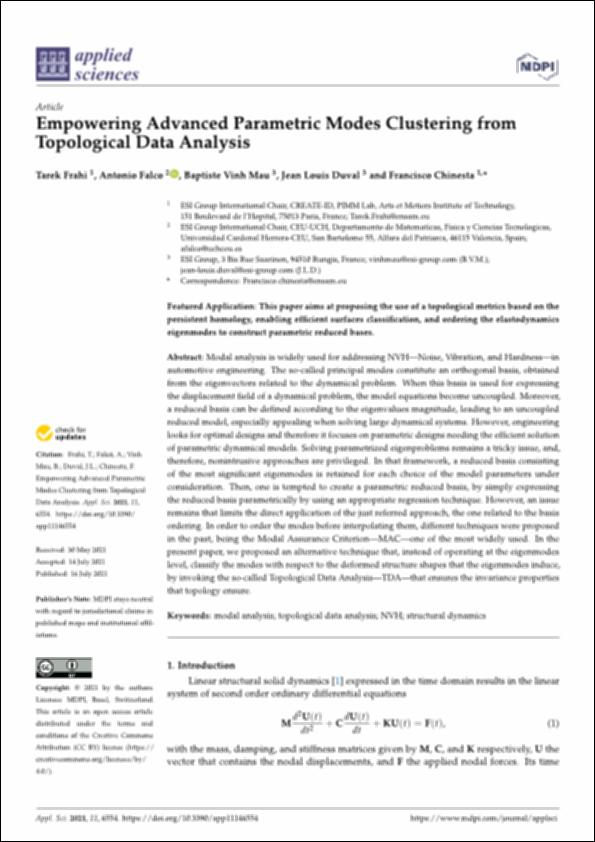Please use this identifier to cite or link to this item:
http://hdl.handle.net/10637/13566Empowering advanced parametric modes clustering from topological data analysis
| Title: | Empowering advanced parametric modes clustering from topological data analysis |
| Authors : | Frahi, Tarek Mau, Baptiste Vinh Duval, Jean Louis Chinesta, Francisco Falcó Montesinos, Antonio |
| Keywords: | Surfaces.; Superficies (Matemáticas); Análisis de datos.; Topology.; Deformations (Mechanics); Deformaciones (Mecánica); Topología.; Data analysis. |
| Publisher: | MDPI |
| Citation: | Frahi, T., Falco, A., Mau, B.V., Duval, J.L. & Chinesta, F. (2021). Empowering advanced parametric modes clustering from topological data analysis. Applied Sciences, vol. 11, i. 14 (16 jul.), art. 6554. DOI: https://doi.org/10.3390/app11146554 |
| Abstract: | Modal analysis is widely used for addressing NVH—Noise, Vibration, and Hardness—in automotive engineering. The so-called principal modes constitute an orthogonal basis, obtained from the eigenvectors related to the dynamical problem. When this basis is used for expressing the displacement field of a dynamical problem, the model equations become uncoupled. Moreover, a reduced basis can be defined according to the eigenvalues magnitude, leading to an uncoupled reduced model, especially appealing when solving large dynamical systems. However, engineering looks for optimal designs and therefore it focuses on parametric designs needing the efficient solution of parametric dynamical models. Solving parametrized eigenproblems remains a tricky issue, and, therefore, nonintrusive approaches are privileged. In that framework, a reduced basis consisting of the most significant eigenmodes is retained for each choice of the model parameters under consideration. Then, one is tempted to create a parametric reduced basis, by simply expressing the reduced basis parametrically by using an appropriate regression technique. However, an issue remains that limits the direct application of the just referred approach, the one related to the basis ordering. In order to order the modes before interpolating them, different techniques were proposed in the past, being the Modal Assurance Criterion—MAC—one of the most widely used. In the present paper, we proposed an alternative technique that, instead of operating at the eigenmodes level, classify the modes with respect to the deformed structure shapes that the eigenmodes induce, by invoking the so-called Topological Data Analysis—TDA—that ensures the invariance properties that topology ensure. |
| Description: | Este artículo se encuentra disponible en la siguiente URL: https://www.mdpi.com/2076-3417/11/14/6554 |
| URI: | http://hdl.handle.net/10637/13566 |
| Rights : | http://creativecommons.org/licenses/by/4.0/deed.es |
| ISSN: | 2076-3417 (Electrónico) |
| Issue Date: | 16-Jul-2021 |
| Center : | Universidad Cardenal Herrera-CEU |
| Appears in Collections: | Dpto. Matemáticas, Física y Ciencias Tecnológicas |
Items in DSpace are protected by copyright, with all rights reserved, unless otherwise indicated.


